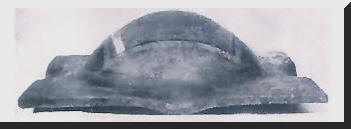WELDING HEAT TREATED 4130 Chrome Moly (QUENCHED AND TEMPERED)
Why Not Use a High
Strength, High Toughness Steel That is Easier to Weld Than 4130 Chrome Moly!
Still want to use
higher strength tubing? Have someone make an alloy like the Navy’s HY-130
which would be
far better choice. I have worked with this product for over 30 years on a
number of applications requiring not only strength but excellent toughness,
i.e. for submarine hulls that can withstand a depth charge!
 One
of the tests the Navy requires to evaluate weldment ductility is the
explosion bulge test. A weld is made in two plates. The plate is
cooled to the required test temperature. The weld seam is placed over a
die having a round hole. A powerful explosive charge is paced above the
welded plate. When ignited, the force is sufficient to push the welded
plate into the hole and form a hat section. The
welded seam is subjected to a tremendous rapid force. The weld, heat affected
zone (HAZ) and base material must yield but show no fractures – even
on thick material! See example of a successful test in photo
above. It takes very ductile base and weld material to pass this
test.
Note in the table below, the HY-130 base metal carbon content is only 0.10 versus 0.30 in 4130.
This makes welding much easier and provides a ductile HAZ.
One
of the tests the Navy requires to evaluate weldment ductility is the
explosion bulge test. A weld is made in two plates. The plate is
cooled to the required test temperature. The weld seam is placed over a
die having a round hole. A powerful explosive charge is paced above the
welded plate. When ignited, the force is sufficient to push the welded
plate into the hole and form a hat section. The
welded seam is subjected to a tremendous rapid force. The weld, heat affected
zone (HAZ) and base material must yield but show no fractures – even
on thick material! See example of a successful test in photo
above. It takes very ductile base and weld material to pass this
test.
Note in the table below, the HY-130 base metal carbon content is only 0.10 versus 0.30 in 4130.
This makes welding much easier and provides a ductile HAZ.
Unfortunately, to my
knowledge, this material is not being made in tubing. It will also
cost more than 4130 because of the alloy content and freedom from
undesirable impurities which can lead to cracking and reduced toughness. In
the chart below you’ll note the steel contains much lower carbon and far
lower undesirable residual elements such as sulfur and phosphorus. That
steel uses expensive elements like 5% Nickel and three times the 0.2%
Molybdenum found in 4130. It is much more weldable than 4130 and the Heat
Affected Zone (HAZ) properties will be satisfactory at normal welding heat
inputs.
This old statement
that 4130 is weldable stems from the 1940’s when folks used gas welding
(read lots of preheat and very slow cooling!) To achieve good weldability
carbon content in base materials and welding rods has reduced over the years and even
100,000 psi yield gas and oil transmission pipe has carbon levels of 0.10
and lower! The following chart presents chemistries and mechanical
properties of plate, welding wire and welds: